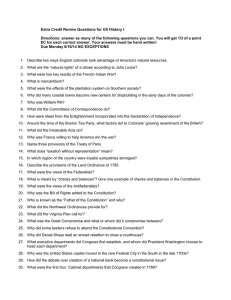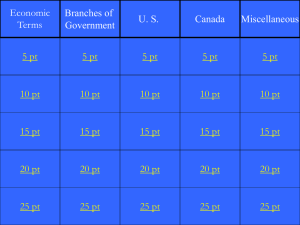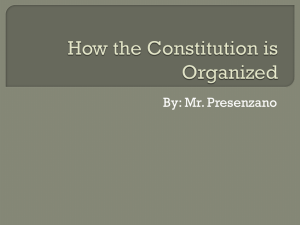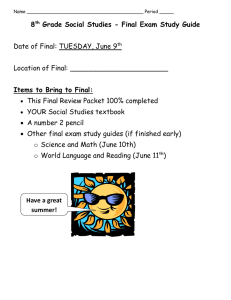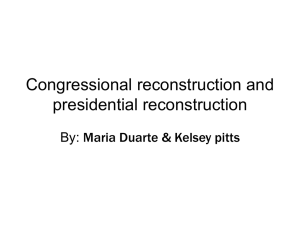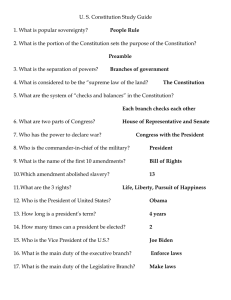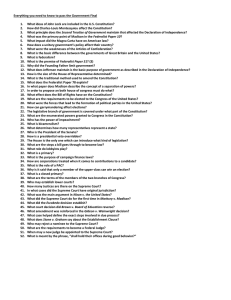Early America (Level 3) Unit 1: Geography
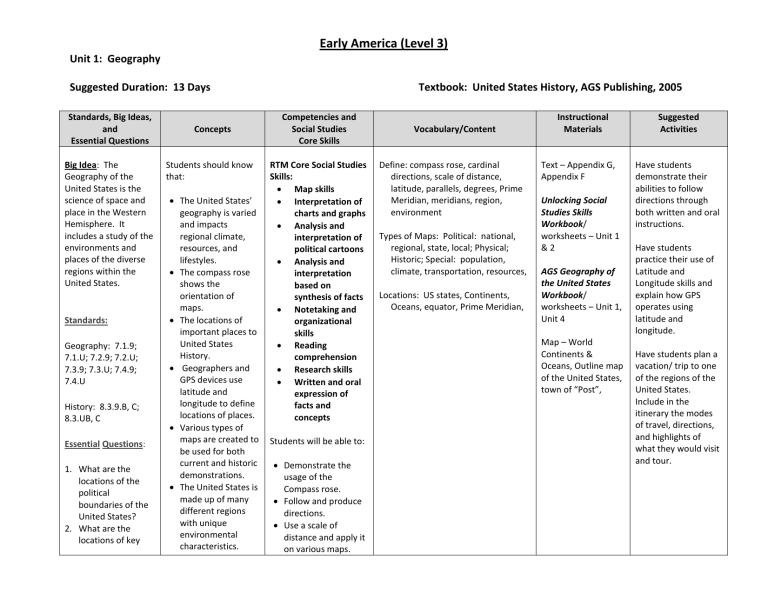
Early America (Level 3)
Unit 1: Geography
Suggested Duration: 13 Days
Standards, Big Ideas, and
Essential Questions
Big Idea : The
Geography of the
United States is the science of space and place in the Western
Hemisphere. It includes a study of the environments and places of the diverse regions within the
United States.
Standards:
Geography: 7.1.9;
7.1.U; 7.2.9; 7.2.U;
7.3.9; 7.3.U; 7.4.9;
7.4.U
History: 8.3.9.B, C;
8.3.UB, C
Essential Questions :
1.
What are the locations of the political boundaries of the
United States?
2.
What are the locations of key
Concepts
Students should know that:
The United States’ geography is varied and impacts regional climate, resources, and lifestyles.
The compass rose shows the orientation of maps.
The locations of important places to
United States
History.
Geographers and
GPS devices use latitude and longitude to define locations of places.
Various types of maps are created to be used for both current and historic demonstrations.
The United States is made up of many different regions with unique environmental characteristics.
Competencies and
Social Studies
Core Skills
RTM Core Social Studies
Skills:
Map skills
Interpretation of charts and graphs
Analysis and interpretation of political cartoons
Analysis and interpretation based on synthesis of facts
Notetaking and organizational skills
Reading comprehension
Research skills
Written and oral expression of facts and concepts
Students will be able to:
Demonstrate the usage of the
Compass rose.
Follow and produce directions.
Use a scale of distance and apply it on various maps.
Textbook: United States History, AGS Publishing, 2005
Vocabulary/Content
Define: compass rose, cardinal directions, scale of distance, latitude, parallels, degrees, Prime
Meridian, meridians, region, environment
Types of Maps: Political: national, regional, state, local; Physical;
Historic; Special: population, climate, transportation, resources,
Locations: US states, Continents,
Oceans, equator, Prime Meridian,
Instructional
Materials
Text – Appendix G,
Appendix F
Unlocking Social
Studies Skills
Workbook / worksheets – Unit 1
& 2
AGS Geography of the United States
Workbook / worksheets – Unit 1,
Unit 4
Map – World
Continents &
Oceans, Outline map of the United States, town of “Post”,
Suggested
Activities
Have students demonstrate their abilities to follow directions through both written and oral instructions.
Have students practice their use of
Latitude and
Longitude skills and explain how GPS operates using latitude and longitude.
Have students plan a vacation/ trip to one of the regions of the
United States.
Include in the itinerary the modes of travel, directions, and highlights of what they would visit and tour.
physical features?
3.
What are unique characteristics of the various regions of the United
States: New
England, Middle
Atlantic, Southeast,
Great Lakes, South
Central, North
Central, Four
Corners, Pacific
Southwest, Pacific
Northwest, Alaska,
Hawaii?
4.
What are the tools used by
Geographers to organize and interpret information?
5.
What are the natural resources of the United
States?
Demonstrate the use of latitude and longitude
Identify the various types of maps and be able to apply them to their studies: political, physical, historic, and a variety of special maps
Compare and contrast the different regions of the United
States and explain the features that make each region distinct.
Early America (Level 3)
Unit 2: The President as Commander in Chief
Suggested Duration: 10 Days
Standards, Big Ideas, and
Essential Questions
Big Idea : The United
States government is divided into three branches: executive, legislative, judicial. The
President is the head of the executive branch of the US government. One of the main responsibilities of the
President is to be the
Commander in Chief of the US military. This role was created and defined through many events in
US history.
Standards:
History: 8.1.9.A; 8.1.UA;
8.2.9.B; 8.2.UB; 8.2.9.D;
8.2.UD; 8.3.9.A,B,C,D;
8.3.UA, B,C, D
Civics: 5.1.9.C, D;
5.1.UC,D; 5.2.9.B,C;
5.2.UB,C; 5.3.9.C
Essential Questions:
1.
What are the three branches of the
United States
Concepts
Students should know that:
The French and
Indian War was started by the
English and their
American allies in the Ohio Valley and gave George
Washington military experience.
The Revolutionary
War was fought against the British for independence, and George
Washington was ultimately the successful commanding general.
Surrender is a formal process with both military and diplomatic outcomes.
The War of 1812 was fought against the British over naval issues and conflicts with the
Native Americans in
Competencies and Social
Studies
Core Skills
RTM Core Social Studies
Skills:
Map skills
Interpretation of charts and graphs
Analysis and interpretation of political cartoons
Analysis and interpretation based on synthesis of facts
Notetaking and organizational skills
Reading comprehension
Research skills
Written and oral expression of facts and concepts
Students will be able to:
Define each branch of government, civilian, military campaign, vaccine, naval warfare, annexation,
Manifest Destiny, unconditional surrender.
Explain the roles of
Vocabulary/Content
Define: executive, legislative, judicial branches of government, President, commander in chief, civilian,
Secretary of Defense,
Pentagon, George
Washington, French &
Indian War, Second
Continental Congress,
Continental Army,
Revolutionary War, Battles of Trenton & Princeton,
Washington’s Crossing the
Delaware, Hessians, Charles
Cornwallis, military campaign, William Howe,
Battle of Brandywine,
Marquis de Lafayette,
Quakers/ Society of Friends, meetinghouses, Valley
Forge, Baron von Steuben, smallpox, vaccine, Battle of
Yorktown, Jean
Rochambeau, James
Madison, War of 1812, naval warfare, Battle of Lake
Erie, Flagship Niagara, Battle of Bladensburg, Dolley
Madison, Battle of Fort
McHenry, Francis Scott Key,
Andrew Jackson, William
Henry Harrison, James K.
Polk, “Fifty-four, forty or
Instructional
Materials
Text – Ch 6 Lessons
2, 4, 5; Ch 9 Lessons
2, 3 and corresponding worksheets
Note taking Packet and study guide
Diagram – the
Branches of the US government
Timeline – Wars in
Early American
History
DVD – “Valley
Forge…to
Remember”; “The
Battle of the
Brandywine; A Battle
Lost – A Revolution
Sustained”
Art – Emanuel
Leutze’s Washington
Crossing the
Delaware; Mort
Küntsler’s
Washington’s
Crossing (2011);
Gilbert Stuart’s
Suggested
Activities
Diagram the three branches of the United
States government.
Develop a presentation about the importance of the Pentagon and diagram the branches of the military.
Do a picture analysis of
Emanuel Leutze’s painting of Washington
Crossing the Delaware.
Use the video guide while viewing “Valley
Forge…to Remember”
Diagram the various wars of Early American history to highlight who were the key generals, presidents, and events.
Compare and contrast the results of the various wars of Early American
History.
Locate on the US map where key battles in
Early American history
government?
2.
What is the role of
Commander in Chief?
3.
What events of history determined that the President would be the
Commander in Chief?
4.
How did various
Presidents lead the
United States through times of war?
5.
What commanding generals went on to become Presidents? the Northwest
Territories while
James Madison was
President.
The Mexican War was fought with
Mexico to annex the lands of Texas while
James K. Polk was
President.
General Zachary
Taylor and Winfield
Scott proved to be highly skilled military leaders during the Mexican
War.
The Civil War divided the nation over many issues including states’ rights and national unity while
Abraham Lincoln was President.
During the Civil
War, the North experienced many changes in commanding general before settling on Ulysses
S. Grant who ultimately defeated the South’s Robert
E. Lee.
Several successful generals have gone on to be elected
President: Andrew
Jackson, William
Henry Harrison,
Zachary Taylor,
Commander in Chief and Secretary of
Defense.
Explain the importance of George
Washington to the creation of the
President as
Commander in Chief based on his leadership during the
Revolutionary War
Differentiate between the Wars of
Early American
History and explain each war’s causes and results.
Point out events from
America’s early wars that have become significant components of
American culture.
Assess the strengths and weaknesses of the Presidents and commanding generals from America’s early wars.
Fight!”, Manifest Destiny, annexation, Mexican War,
Zachary Taylor, Winfield
Scott, Abraham Lincoln, Civil
War, slavery, states’ rights,
George B. McClellan,
Ulysses S. Grant, unconditional surrender portrait of
Washington
Music – Francis Scott
Key’s “Star Spangled
Banner”
Photos –
Pennsylvania’s
Flagship USS Niagara
Web sites:
Pentagon, Fort
McHenry
Primary Source – US
Constitution took place.
Ulysses S. Grant,
Dwight D.
Eisenhower.
Early America (Level 3)
Unit 3: The President and Foreign Policy
Suggested Duration: 10 Days
Standards, Big Ideas, and
Essential Questions
Big Idea : One of the main functions of the
President is to manage the United States’ relations with foreign countries.
Standards:
History: 8.1.9.A; 8.1.UA;
8.2.9.B; 8.2.UB; 8.2.9.D;
8.2.UD; 8.3.9.A,B,C,D;
8.3.UA, B,C, D
Civics: 5.1.9.C, D;
5.1.UC,D; 5.2.9.B,C;
5.2.UB,C; 5.3.9.A,C;
5.4.9.A,B,E; 5.4.UA,B
Essential Questions:
1.
What specifically is involved in conducting foreign relations?
2.
What were the terms of the treaties signed by the United States during the early years of history?
3.
How did the United
States achieve the goal of “Manifest
Concepts
Students should know that:
The Secretary of
State is the advisor to the President on foreign relations and often plays a key role in negotiations with other countries.
The Treaty of Paris,
1783 ended the
Revolutionary War, established our official independence, and defined our boundaries.
The Louisiana
Purchase was an interpretive struggle for President
Jefferson but ultimately doubled the size of the
United States and allowed access to the Pacific Ocean.
The Lewis & Clark
Expedition, better known as the Corps of Discovery, not
Competencies and Social
Studies
Core Skills
RTM Core Social Studies
Skills:
Map skills
Interpretation of charts and graphs
Analysis and interpretation of political cartoons
Analysis and interpretation based on synthesis of facts
Notetaking and organizational skills
Reading comprehension
Research skills
Written and oral expression of facts and concepts
Students will be able to:
Define foreign relations, alliance, ambassador, embassy, treaty, ratification, status quo, compromise, transcontinental railroad.
Explain the process of
Vocabulary/Content
Define: foreign relations, alliance, Secretary of State, ambassadors, embassy, treaty, ratification, Treaty of
Paris, 1783, Ben Franklin,
John Adams, Louisiana
Purchase, Thomas
Jefferson, Lewis & Clark
Expedition, Sacagawea,
Rocky Mountains, Fort
Clatsop, Clark’s Map, Treaty of Ghent, status quo,
Western Hemisphere,
Christopher Columbus,
“New World,” Monroe
Doctrine, James Monroe,
Manifest Destiny, Treaty of
1846, compromise, Treaty of Guadalupe–Hidalgo, Rio
Grande, Mexican Cession,
Gadsden Purchase, transcontinental railroad,
Alaska, Andrew Johnson,
William Seward
Instructional
Materials
Text – Ch 6 Lesson 6,
Ch 8 Lesson 4,5, Ch
10 Lesson 3, Ch 13
Lesson 2 and corresponding worksheets
Time Line – Treaties
& Land purchases
Note taking packet and study guide
Map – Manifest
Destiny – Expansion of the US
DVD – “Lewis &
Clark: The Great
Journey West”
Suggested
Activities
Examine the impact of the Monroe Doctrine on
United States foreign policy today.
Discuss the similarities and differences of the various treaties entered into by the United States in our early history.
Research the resources and discoveries that happened in the territories added to the
United States.
Share excerpts from
Abraham Lincoln’s “Spot
Resolutions.” Have a discussion about the complications regarding slavery also expanding hand in hand with the
United States.
Present the students with the following:
“Much of today’s resentment on the part of Latin and South
American nations toward their ‘Big Brother to the
Destiny”? only traced the first routes across the continent but also discovered new plants and animals and resulted in the first map of the interior parts of the
US.
The Treaty of Ghent ended the War of
1812 and ever since
Britain has been our strongest ally.
The Monroe
Doctrine that closed the Western
Hemisphere to colonization is still the keystone of our foreign policy today.
The Treaty of
Guadalupe –Hidalgo ended the Mexican
War and granted the
US the Mexican
Cession. ratifying a treaty.
Recall and explain the treaties ratified by the United States with other nations.
Analyze the significance to the
United States of the acquisition of lands during the territorial expansion.
North’ is due to the
Monroe Doctrine.”
Encourage them to formulate an explanation for the statement.
Standards, Big Ideas, and
Essential Questions
Big Idea : The
Constitution clearly states specific requirements in order to be President and certain duties assigned to the
President, while the 12 th
Amendment defines the
Electoral College process.
Standards:
History: 8.1.9.A,B;
8.1.UA,B; 8.3.9.A,B,C,D;
8.3.UA,B,C,D
Civics: 5.1.9.C,D;
5.2.9.C,D; 5.3.9.D,E;
5.1.UC,D; 5.2.UC,D;
5.3.UD
Geography: 7.3.9.A;
7.3.UA
Essential Questions:
1.
What are the requirements to run for the office of
President?
2.
How does the
Presidential election
Early America (Level 3)
Unit 4: Election of a President & Other Presidential Duties
Suggested Duration: 6 Days
Concepts
Students should know that:
The Constitution indicates certain requirements for a person to run for
President.
The role of the Vice
President changes over time and is different with various presidents.
The President is elected through a long process to ensure that he/she is truly representing all of the people of the United States.
Any President is advised by his/her
Cabinet.
Presidents have the ability to grant pardons and reprieves and appoint people to various positions in the United States government.
The State of the
Union address is a
Competencies and Social
Studies
Core Skills
RTM Core Social Studies
Skills:
Map skills
Interpretation of charts and graphs
Analysis and interpretation of political cartoons
Analysis and interpretation based on synthesis of facts
Notetaking and organizational skills
Reading comprehension
Research skills
Written and oral expression of facts and concepts
Students will be able to:
Define term of office, natural born citizen, chain of succession, primary election, caucus, political campaign, Electoral
College, pardon, reprieve, impeachment,
Vocabulary/Content
Define: natural born citizen, term of office, 22 nd
Amendment, Electoral
College, Vice President, 25 th
Amendment, Presidential
Succession Act, primary election, caucus, national convention, political campaign, general election, registered voter, inauguration, oath of office,
20 th
Amendment, popular vote, electoral vote, 12 th
Amendment, John Adams,
Thomas Jefferson, Election of 1796, Cabinet, pardon, reprieve, State of the Union, impeachment, indictment,
Chief Justice, Andrew
Johnson, Bill Clinton,
Richard Nixon
Instructional
Materials
Text –Ch 8 Lesson 3,
Ch 13 Lesson 1, Ch
17 Lesson 2, and corresponding worksheets
Elections Workbook
– worksheets on
Article 2 of the
Constitution , flow chart diagram of the election process, popular vote, electoral votes
DVD – “White House
Revealed”;
Presidential
Inauguration excerpts
Primary Source – US
Constitution
Suggested
Activities
Have the students discuss why the
Founding Fathers determined that the
President should be a natural born citizen, the only position in the government defined as such. Also discuss the controversial accusations by some that question
Barack Obama’s citizenship status.
Discuss the medical and technological advancements in society that required
Amendments to added to the Constitution
Have students recreate various elections in history or predict a future election’s results using the Electoral
College and various candidates’ vote tallies.
Compare and contrast the impeachments of
Andrew Johnson and Bill
Clinton with the
process work?
3.
Why is the Electoral
College still used today?
4.
What are the other duties of the
President as required by the Constitution ?
5.
In what other ways does the President lead the United
States that is not defined by the
Constitution but has evolved through time? requirement for the
President to deliver annually.
Two Presidents in
United States history have been impeached and found not guilty. indictment.
Explain how the 12 th
,
20 th
, 22 nd
, and 25 th
Amendments to the
Constitution have altered or clarified the election process of the President and the role of the Vice
President.
Trace the process of electing a President from the primaries through the
Inauguration.
Assess the importance of the official and unofficial duties of the
President to the functioning of the
United States’ government.
Understand the process of
Impeachment and the history of this process in the United States. resignation of Richard
Nixon
Early America (Level 3)
Unit 5: How the Legislative Branch Began
Suggested Duration: 10 Days
Standards, Big Ideas, and
Essential Questions
Big Idea : The US
Congress developed over time during the Colonial period through a series of steps taken at various meetings of the colonies.
Standards:
History: 8.1.9; 8.1.U;
8.2.9.A,B,D; 8.2.UA,B,D;
8.3.9; 8.3.U
Civics: 5.1.9.C,D,F;
5.1.UC,D,F; 5.2.9.B,D;
5.2.UB,D; 5.3.9.G,I,J
Geography: 7.1.9.B;
7.3.9.A; 7.3.UA
Economics: 6.3.9.B,C,D;
6.3.UB,C,D
Essential Questions:
1.
How is the Congress divided into the
Senate and House of
Representatives?
2.
What was the history behind the creation of the US Congress?
3.
What colonial
Concepts
Students should know that:
The United States began as English colonies.
Mercantilism was the guiding economic policy of the British
Empire.
Jamestown was the first permanent
English colony in
America.
The House of
Burgesses was the first legislative body in America.
The Albany Plan of
Union was the first proposal made to unite the 13 English colonies in America.
The Stamp Act
Congress brought the colonies together to protest the Stamp tax; a tax without representation.
The First Continental
Congress allowed the colonies to come together to support
Competencies and Social
Studies
Core Skills
RTM Core Social Studies
Skills:
Map skills
Interpretation of charts and graphs
Analysis and interpretation of political cartoons
Analysis and interpretation based on synthesis of facts
Notetaking and organizational skills
Reading comprehension
Research skills
Written and oral expression of facts and concepts
Students will be able to:
Define legislative branch, colony, mercantilism, burgess, boycott, foreshadowing, resolution, unalienable rights.
Trace the development of the
Vocabulary/Content
Define: legislative branch,
Congress, Senate, House of
Representatives, English colonies, King of England,
Parliament, Prime Minister, colony, parent country, mercantilism, Jamestown,
John Smith, Pocahontas,
John Rolfe, House of
Burgesses, slavery, Albany
Conference, French &
Indian War, Iroquois
Confederation, Huron,
Algonquin, Albany Plan of
Union, Ben Franklin, “Join or Die,” Stamp Act
Congress, Stamp Act, direct vs. indirect tax, “no taxation without representation,” boycott,
First Continental Congress,
Boston Tea Party,
Intolerable Acts/ Coercive
Acts, Patrick Henry, Paul
Revere, William Dawes,
Samuel Prescott, Henry
Wadsworth Longfellow,
Battles of Lexington &
Concord, “shot heard
‘round the world,” minutemen, Second
Continental Congress, Olive
Branch Petition, George III,
Instructional
Materials
Text – Ch 3 Lessons
1, 3; Ch 4 Lesson 3;
Ch 5 Lesson 4; Ch 6
Lesson 3 and corresponding worksheets
Note taking packet and Review Sheet
Primary Sources:
Patrick Henry’s “Give
Me Liberty or Give
Me Death,” Lee’s
Resolution,
Declaration of
Independence
Political Cartoon –
Ben Franklin’s “Join or Die”
DVD – Disney’s
“Pocahontas II,”
School House Rock ,
America Rock segments:
“Fireworks,” & “The
Shot Heard ‘Round the World’”
Worksheet – A
Cartoon With a
Suggested
Activities
Analyze the significance of Jamestown and discuss this statement:
“Jamestown should have failed.”
Analyze Dr. Franklin’s use of the “severed snake” cartoon to dramatize the need for colonial unity during the
French and Indian War.
Could Franklin have improved the cartoon – or is it sufficiently effective as is? Why or why not?
Share the poetry of
Longfellow and/ or
Emerson to tell the story of the first day of the
Revolutionary War; have students highlight or mark copies of the poem that they “like,” and then as a class,
“perform” the poem having students join in the recitation during the segments that they highlighted. Discuss patterns when
assemblies contributed to the eventual development of the
United States’ legislative branch?
Boston after the
Boston Tea Party and ensuing Coercive
Acts.
The Battles of
Lexington and
Concord marked the beginning of the
Revolutionary War, the war for
Independence.
The Second
Continental Congress was the first meeting of all 13 English
Colonies in America.
Lee’s Resolution led to the writing and acceptance of the
Declaration of
Independence .
English colonies in
America.
Assess the importance of each meeting held in the colonies prior to declaring.
Independence
Discuss the concept of taxation without representation.
Analyze the
Declaration of
Independence.
Richard Henry Lee, Lee’s
Resolution, Thomas
Jefferson, Declaration of
Independence , John Adams, unalienable rights, John
Hancock
Caption from
American
Adventures
Historical Cartoons
Literature –
“Midnight Ride of
Paul Revere” by
Henry Wadsworth
Longfellow,
“Concord Hymn” by
Ralph Waldo
Emerson
Map – 13 Colonies complete.
Ask the students to consider how much the creed “that all men are created equal” has continued relevance to the America in which they live. Encourage the students to point out historical injustices beyond slavery. Ask the students to hypothesize about this statement:
“The United States, in all its aspects, is not perfect, but always a work in progress toward its ideals. And all kinds of people have died for that belief.”
Early America (Level 3)
Big Idea : The United
States Constitution created the US Congress, defined the requirements to run for
Congress, and specified what the Congress could and could not do.
Standards:
History: 8.1.9; 8.1.U;
8.2.9; 8.2.U; 8.3.9; 8.3.U
Civics: 5.1.9; 5.1.U;
5.2.9; 5.3.9.A,B,C,E,I
Geography: 7.1.9.B;
7.3.9.A; 7.3.UA
Economics: 6.1.9.C;
6.1.UC; 6.2.9.G; 6.2.UG;
6.3.9.B,C,D; 6.3.UB,C,D
Essential Questions:
1.
What compromises led to the development of the
US Congress and the ratification of the document during
Unit 6: Congress: How it works
Suggested Duration: 10 Days
Standards, Big Ideas, and
Essential Questions Concepts
Students should know that:
The United States
Constitution created the US Congress by the Great
Compromise which determined the makeup of the
Senate and the
House of
Representatives.
The Constitution had to be ratified by nine states but that further compromises allowed for Virginia and New York’s ratifications prior to the first elections being held in the
United States.
The Bill of Rights is made up of the first
10 Amendments to the Constitution .
Congress controls the money of the US government – taxation, printing,
Competencies and Social
Studies
Core Skills
RTM Core Social Studies
Skills:
Map skills
Interpretation of charts and graphs
Analysis and interpretation of political cartoons
Analysis and interpretation based on synthesis of facts
Notetaking and organizational skills
Reading comprehension
Research skills
Written and oral expression of facts and concepts
Students will be able to:
Define compromise, ratification, amendment, types of taxes, capitalism, imports, exports, lobbyist, sedition, veto.
Explain how the US
Vocabulary/Content
Define: Constitution al
Convention, Great
Compromise, compromise,
Virginia Plan, New Jersey
Plan, Roger Sherman, ratification, Federalists,
George Washington, James
Madison, Anti-Federalists,
Patrick Henry, George
Mason, Bill of Rights, amendments, taxation,
Secretary of the Treasury,
Alexander Hamilton, income tax, 16 th
Amendment, property tax, sales tax, capitalism, Adam Smith, US
Mint, First National Bank of the United States, Federal
Reserve System, imports, exports, slave trade, interstate trade, elastic clause, Daniel Webster, lobbyist, Alien & Sedition
Acts, sedition, Homestead
Act, How a bill becomes a
Law, committee, “die in committee,” conference committee, veto, override veto
Instructional
Materials
Text – Ch 7 Lesson 5,
Ch 8 Lessons 1-2 and corresponding worksheets
Note taking Packet and Study Guide
DVD – School House
Rock , America Rock segment: “I’m Just a
Bill”
Chart – How a Bill becomes a Law
Web sites – US
Treasury, US Mint
Biography – Adam
Smith with excerpt from “The Wealth of
Nations”
Primary Source – US
Constitution
Suggested
Activities
Have students discuss the fact that the
Constitution al
Convention was held in secrecy and what potentially would happen if the US government tried to hold meetings in secrecy today.
Have students
“translate” the words of the Bill of Rights into usable language to better understand the rights protected in the first ten amendments.
Have students do research to compare and contrast the various economic systems used around the world.
Discuss the compromises Alexander
Hamilton made to ensure passage of the
First National Bank of the United States and how that impacted the
and after the
Constitution al
Convention?
2.
What powers are granted to the US
Congress by the
Constitution ?
3.
How are the powers of Congress expanded through the use of the elastic clause?
4.
What roles do
Senators and
Representatives fill? and spending
Alexander Hamilton determined that the
United States would follow capitalism as the economic system.
The process to create laws involves many steps.
Constitution created the Congress and was ratified by the states.
Compare and contrast the arguments of the
Federalists and Anti-
Federalists.
Describe capitalism.
Contrast different types of taxes.
Assess the importance of the elastic clause in the
Constitution.
Trace the process of how a bill becomes a law and what could happen after a
Presidential veto. location of the nation’s capital.
Early America (Level 3)
Unit 7: The Judicial Branch
Suggested Duration: 5 Days
Standards, Big Ideas, and
Essential Questions Concepts
Big Idea : The judicial branch in the United
States is headed by the
Supreme Court and the duties of the judicial branch are defined by the US Constitution and federal law.
Standards:
History: 8.1.9; 8.1.U;
8.3.9; 8.3.U
Civics: 5.1.9.A,C,D;
5.1.UA,C,D; 5.2.9.B;
5.2.UB; 5.3.9.A,F; 5.3.UF
Essential Questions:
1.
What does the US
Supreme Court do to interpret laws?
2.
What is the difference between federal and state courts and between criminal and civil cases?
3.
What are the rights of an accused person in the United States?
4.
What are landmark
Students should know that:
The judicial branch is made up of all the courts in the United
States, and cases from any court could be appealed to the US Supreme
Court.
The type of case (or laws violated) determines if a case is tried in federal courts or state courts.
Any person arrested must be informed of his or her Miranda
Rights and that the writ of habeas corpus cannot be suspended unless during a time of crisis.
Both criminal and civil cases begin at the lowest level of courts and could then proceed on appeal up through the various levels of
Competencies and Social
Studies
Core Skills
RTM Core Social Studies
Skills:
Map skills
Interpretation of charts and graphs
Analysis and interpretation of political cartoons
Analysis and interpretation based on synthesis of facts
Notetaking and organizational skills
Reading comprehension
Research skills
Written and oral expression of facts and concepts
Students will be able to:
Define judicial branch, arraignment, prosecutor, defense attorney, verdict, judicial review
Compare and contrast federal cases with state cases; and criminal law from civil
Vocabulary/Content
Define: judicial branch, federal court, state court, federal law, state/ local law,
Miranda Rights, public defender, writ of habeas corpus , arraignment, defendant, prosecutor, defense attorney, verdict, appeal, appeals courts, state supreme court, US Supreme
Court, Justices, Chief Justice, judicial review, Andrew
Jackson, John Marshall,
Cherokee, Trail of Tears, criminal law, “beyond a reasonable doubt,” civil law,
“preponderance of the evidence”
Instructional
Materials
Text – Ch 7 Lesson 4,
Ch 11 Lesson 3 and corresponding worksheets; and
Appendix H
Note taking Packet and Study Guide
Elections Workbook
– worksheet on
Article 3 of the
Constitution
Chart – US Court
System
DVD – School House
Rock , America Rock segment: “Three
Ring Government”
Supreme Court
Cases – Cherokee
Nation v. Georgia,
Worcester v.
Georgia; Miranda v.
Arizona; Bush v.
Gore
Web sites –
Landmark Supreme
Court cases; US
Suggested
Activities
Have students research landmark Supreme
Court cases and report on how those decisions impacted the United
States
Have students follow the developments of a high profile case in the news; either in the past or from current events
Set up a Mock Trial activity
Create a project centered on the theme of the Trail of Tears
cases of the US
Supreme Court? the US court system.
Supreme Court decisions impact all of the United States and may only be changed either by
Amendment to the
Constitution or by the Supreme Court ruling differently in another case. law.
Explain the Miranda
Rights and the writ of habeas corpus.
Describe the functions of the courts.
Trace the appeals process.
Understand the concepts of judicial review, beyond a reasonable doubt, preponderance of the evidence.
Explain the significance of
Andrew Jackson’s defiance of the
Supreme Court and the resulting Trail of
Tears for the
Cherokee Indians.
Supreme Court
Early America (Level 3)
Big Idea : Sectionalism and, ultimately, the Civil
War, were caused by the issue of the spread of slavery to the territories.
Standards:
History: 8.1.9; 8.1.U;
8.3.9; 8.3.U
Civics: 5.1.9; 5.1.U;
5.2.9; 5.2.U; 5.3.9
Economics: 6.1.9.B;
6.1.UB; 6.3.9.B; 6.3.UB,D
Geography: 7.1.9.B;
7.3.9.A; 7.3.UA; 7.4.9.B;
7.4.UB
Essential Questions:
1.
How did the opinions of the various sections of the country contribute to the causes of the coming Civil War?
2.
What issues contributed to the
Unit 8: Causes of the Civil War
Suggested Duration: 8 Days
Standards, Big Ideas, and
Essential Questions Concepts
Students should know that:
The Missouri
Compromise established a dangerous precedent of insisting that the number of slave states remain in balance with the number of free states.
The abolitionist movement spread through the
Northern parts of the United States.
A series of elections produced relatively weak presidents unable to prevent or alter the course of the country towards division.
Several laws and events (Compromise of 1850, “Uncle
Tom’s Cabin,”
Kansas – Nebraska
Competencies and Social
Studies
Core Skills
RTM Core Social Studies
Skills:
Map skills
Interpretation of charts and graphs
Analysis and interpretation of political cartoons
Analysis and interpretation based on synthesis of facts
Notetaking and organizational skills
Reading comprehension
Research skills
Written and oral expression of facts and concepts
Students will be able to:
Define abolition, fugitive, secession, popular sovereignty, stereotype, arsenal.
Explain how Manifest
Destiny and its by-
Vocabulary/Content
Define Missouri Compromise, abolitionist, Underground
Railroad, Harriet Tubman,
Mason – Dixon Line, Election of 1848, Zachary Taylor, Free
Soil Party, Henry Clay, secession, Compromise of
1850, popular sovereignty,
Fugitive Slave Law, Daniel
Webster, John C. Calhoun,
Millard Fillmore, Franklin
Pierce, “Uncle Tom’s Cabin,”
Harriet Beecher Stowe, stereotyping, Kansas –
Nebraska Act, Stephen
Douglas, transcontinental railroad, “Bleeding Kansas,”
Emigrant Aid Society,
“Beecher’s Bibles,” John
Brown, Brooks – Sumner
Affair, Republican Party,
James Buchanan, John C.
Fremont, Dred Scott Case,
Roger B. Taney, 5 th
Amendment, Congressional elections, Abraham Lincoln,
Lincoln – Douglas Debates,
Freeport Doctrine, John
Brown’s Raid, Harper’s
Ferry, arsenal, Robert E. Lee, martyr, Election of 1860,
Instructional
Materials
Text – Chapter s 14
& 15 and corresponding worksheets for each lesson
Note taking packet and Study Guide
Worksheets from
History of the
United States ,
Volume 1 - #67 -1 &
3; # 68 -7
Map: The States
Choose Sides
Chart – Events
Leading to the Civil
War
Reading: Excerpts from Uncle Tom’s
Cabin
Primary Source –
Lincoln’s First
Inaugural Address
Suggested
Activities
Have the students participate in a simulated activity tied to the Underground
Railroad and/ or the
Lincoln – Douglas
Debates.
Create a timeline of events leading towards the Civil War to illustrate the building tensions
Research the newspaper accounts of the Lincoln –
Douglas Debates to appreciate how these debates both cost
Douglas the presidency in 1860 and introduced the nation to Lincoln at the same time.
Discuss the significance of the Dred Scott Case and future need for either amendments to the Constitution to change the decision or new justices to the
Supreme Court to be
tensions between the sections?
3.
How did each branch of the US government add to the factors that ended up splitting the country?
4.
Could the Civil War have been averted?
Act, Dred Scott Case,
John Brown’s Raid) contributed to the growing sectionalism in the country during the
1850s.
Secession as an action went from being considered a radical concept to an expected outcome and inevitability.
The election of
Abraham Lincoln, a
Republican
President in 1860, who won on a platform of
“Stopping the
Spread of Slavery to the Territories,” led directly to the creation of the
Confederacy.
The outbreak of the
Civil War can be viewed as a failure of the American political system. product (the acquisition of territory by the
United States) contributed mightily to the Civil War by creating the crucial and far-reaching issue of the spread of slavery to the territories.
Evaluate the impact of the creation of the
Free Soil Party, the
Republican Party, the
Compromise of 1850, the Dred Scott
Decision, the Kansas-
Nebraska Act,
“Bleeding Kansas,” the Lincoln-Douglas
Debates, Popular
Sovereignty,
Abolition, the
Underground
Railroad, Uncle Tom’s
Cabin , John Brown’s
Raid at Harpers Ferry, and the Election of
1860.
Dismiss the argument that slavery was not the major cause of the Civil War.
John Breckinridge, John Bell,
Constitution al Union Party,
Confederate States of
America, Jefferson Davis,
Fort Sumter able to reverse the rulings.
Early America (Level 3)
Unit 9: The Civil War
Suggested Duration: 7 Days
Standards, Big Ideas, and
Essential Questions Concepts
Big Idea : The Civil War redefined America. The
Civil War was a revolutionary conflict, essentially the first
“modern war.”
Standards:
8.1.9
Essential Questions:
1.
In what ways can the
Civil War be considered a revolutionary conflict/the first
“modern/total war”?
2.
What factors explain the Union’s victory over the Confederacy in the Civil War? How was victory achieved?
3.
In what ways did the
Civil War affect the home front in
America and
American foreign policy?
4.
How did Abraham
Students should know that:
The Civil War changed military strategies and weaponry, beginning the era of modern warfare.
The Confederate leadership and will to fight was far better / stronger than that of the
Union
Despite being willing to fight a war to preserve the Union, not all Northerners were ready to fight a war to free the slaves.
The Union victory over the
Confederacy in the
Civil War was a consequence of numerical, agricultural, industrial, technological, and
Competencies and Social
Studies
Core Skills
RTM Core Social Studies
Skills:
Map skills
Interpretation of charts and graphs
Analysis and interpretation of political cartoons
Analysis and interpretation based on synthesis of facts
Notetaking and organizational skills
Reading comprehension
Research skills
Written and oral expression of facts and concepts
Students will be able to:
Define secession, emancipation, total war, war of attrition, precedent, malice, surrender, reconciliation.
Vocabulary/Content
Define Fort Sumter, 1 st
& 2 nd
Bull
Run (Manassas), Monitor v.
Merrimack (Virginia), Shiloh,
Antietam, Emancipation
Proclamation, 54 th
Massachusetts Volunteers,
Chancellorsville, Vicksburg,
Gettysburg, Gettysburg
Address, March to the Sea, total war, war of attrition,
Atlanta, Election of 1864, precedent, “with malice toward none,” Five Forks,
Petersburg, Richmond,
Appomattox Courthouse, surrender, reconciliation,
Lincoln’s assassination, John
Wilkes Booth
Union Leadership: Robert
Anderson, Winfield Scott,
George B. McClellan, Ulysses
S. Grant, Abraham Lincoln,
George Meade, Joshua
Lawrence Chamberlain,
William T. Sherman
Confederate Leadership: P.T.
Beauregard, Robert E. Lee,
Stonewall Jackson, Jefferson
Davis, James Longstreet
Instructional
Materials
Text – Chapter 16 and corresponding worksheets
Note taking Timeline and Study Guide
Map – Battlefields of the Civil War
DVD – “Glory,”
“Gettysburg”
Primary Sources –
Gettysburg Address,
Emancipation
Proclamation,
Lincoln’s Second
Inaugural Address
Suggested
Activities
Have the students research the biography of George B. McClellan to make his family connection to local history – George
“Brinton” McClellan, recognizing that the local family being predominately Quakers does not include him in the local histories.
Have students select a battle of the Civil War to research and produce a project that highlights the events during the battle and the significance of the outcome.
Create “playing cards” of the leadership of both the Union and
Confederates that includes key biographical information about each leader.
Lincoln alter the purpose of the Civil
War from being predominately to preserve the Union to include the emancipation of
African Americans? eventual leadership superiority enjoyed by the USA.
The Civil War was the first American war that dramatically affected and impacted the home front.
The Civil War was the bloodiest conflict in all of US
History.
The assassination of
Lincoln dramatically altered the aftermath and hopes for a forgiving peace
Compare the advantages the Union and the Confederacy had entering the Civil
War.
Analyze the significances of the major battles of the
Civil War (Bull Run,
Shiloh, Antietam,
Chancellorsville,
Gettysburg,
Vicksburg, Atlanta,
Petersburg).
Discuss the importance of such events / documents as the Emancipation
Proclamation,
Gettysburg Address, the March to the Sea,
Lincoln’s Second
Inaugural Address, the surrender terms at Appomattox, and
Lincoln’s assassination.
Early America (Level 3)
Big Idea : Reconstruction created a larger federal government.
Reconstruction changed the status of African
Americans in America forever and helped redefine the republic.
Standards:
History: 8.1.9.A,B;
8.1.UA, B; 8.3.9; 8.3.U
Civics: 5.1.9C; 5.1.UC;
5.2.9.B,C; 5.2.UB,C;
5.3.9.C,F,G; 5.3.UF
Economics: 6.1.9.A,B;
6.1.UA, B; 6.2.9.D;
6.2.UD; 6.3.9.A;
6.3.UB,D; 6.4.UC
Geography: 7.1.9; 7.1.U
Essential Questions:
1.
What factors shaped and defined the process of
Reconstruction?
2.
How was the status
Unit 10: Reconstruction
Suggested Duration: 5 Days
Standards, Big Ideas, and
Essential Questions Concepts
Students should know that:
The Civil War and
Reconstruction redefined the republic, doing more than any other single historical event to transform the ideals of the
Declaration of
Independence into reality.
The status of
African-Americans was changed forever by the Civil War and
Reconstruction; three million people were released from servitude and became free men and women.
The President and the Radical
Republican Congress argued over who controlled the process but ultimately Congress ran Reconstruction.
Competencies and Social
Studies
Core Skills
RTM Core Social Studies
Skills:
Map skills
Interpretation of charts and graphs
Analysis and interpretation of political cartoons
Analysis and interpretation based on synthesis of facts
Notetaking and organizational skills
Reading comprehension
Research skills
Written and oral expression of facts and concepts
Students will be able to:
Define amnesty, oath of allegiance, freemen, black codes, carpetbaggers, scalawags.
Determine the importance of the
Vocabulary/Content
Define Reconstruction, amnesty,
Ten Percent Plan, oath of allegiance, 13 th
Amendment, freemen,
Civil Rights Act of 1866,
14 th
Amendment, 15 th
Amendment, Radical
Republicans, Freedmen’s
Bureau, Reconstruction
Acts, Tenure of Office Act,
Andrew Johnson, Black
Codes, Ku Klux Klan,
Enforcement Acts, Election of 1868, Ulysses S. Grant,
Election of 1876,
Rutherford B. Hayes,
Samuel J. Tilden,
Compromise of 1877, carpetbaggers, scalawags
Instructional
Materials
Text – Chapter 17 and corresponding worksheets
Note taking Packet and Study Guide
Primary Source:
13 th
, 14 th
, 15 th
Amendments
Video: “Gone with the Wind” segments
Suggested
Activities
Have students participate in a panel discussion focusing on the question, “How did the Civil War change
America forever?”
Have students speculate on the topic of their choice, “Reconstruction
If Lincoln Had Lived” or
“What If the South had
Won the Civil War?”
Have students recreate the impeachment trial of
Andrew Johnson to reinforce how the process takes place.
of African-Americans changed forever by the Civil War and
Reconstruction?
3.
While Reconstruction is historically viewed as a failure, what were its enduring successes?
The United States, especially the South, had to rebuild emotionally, socially, economically, and politically during the
Reconstruction Era.
13 th
, 14 th
and 15 th
Amendments for the
United States.
Analyze the impeachment of
Andrew Johnson and view it as a product of political maneuvering.
Discuss the Elections of the Reconstruction
Era (1868, 1872,
1876) and the culminating
Compromise of 1877 that ended official
Reconstruction.
Identify the growth of domestic terrorist organizations during the Reconstruction
Era like the Ku Klux
Klan.

